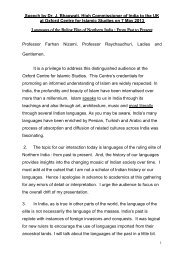India's - High Commission of India, London
India's - High Commission of India, London
India's - High Commission of India, London
Create successful ePaper yourself
Turn your PDF publications into a flip-book with our unique Google optimized e-Paper software.
[ ] 1st issue <strong>of</strong> April 2013 6<br />
A tribute to ‘Jane Austen’ <strong>of</strong> <strong>India</strong><br />
Described by English writer-editor Ian Jack as the Jane Austen <strong>of</strong> <strong>India</strong>, award-winning novelist and<br />
screenplay writer Ruth Prawar Jhabvala was known for her evocative novels <strong>of</strong> 19-20th century <strong>India</strong><br />
Award-winning novelist and<br />
screenplay writer Ruth<br />
Prawar Jhabvala’s novels were<br />
full <strong>of</strong> rich colour and details<br />
<strong>of</strong> <strong>India</strong> that she had adopted as her<br />
homeland, and the people inhabiting<br />
her books were like her — global citizens<br />
juxtaposed against <strong>India</strong>n society<br />
and drawing on the commonalities and<br />
the clash <strong>of</strong> cultures.<br />
Jhabvala, 85, died on April 3 in her<br />
Manhattan home <strong>of</strong> a pulmonary disorder,<br />
long-time friend and associate<br />
James Ivory told the media. She lived<br />
in a modest apartment in Manhattan<br />
decked up with books and the trophies<br />
she brought home for her writing.<br />
Jhabvala moved to <strong>India</strong> in the early<br />
1950s following her remarriage to Parsi<br />
architect Cyrus Jhabvala. The era with<br />
its vestiges <strong>of</strong> the British Raj, the decadence<br />
<strong>of</strong> the native royalty, the economic<br />
gulf between the elite and the<br />
masses, cultures, relationships across<br />
multi-ethnic lines and lifestyles that<br />
allowed the tradition and western modernism<br />
to co-exist captured the literary<br />
imagination <strong>of</strong> the young English literature<br />
post-graduate from the<br />
University <strong>of</strong> <strong>London</strong>.<br />
Two <strong>of</strong> her iconic classics were The<br />
Householder (1960) and Heat and Dust<br />
(1975) that won the Booker Prize for<br />
1975. Both <strong>of</strong> them were adapted into<br />
movies by Merchant-Ivory<br />
Productions, with whom she collaborated<br />
for nearly 50 years for nearly twodozen<br />
scripts.<br />
The Householder is built around its<br />
lead character Prem, who graduates<br />
from a student to householder. It<br />
Crossover Literature: Ruth Prewar Jhabvala with husband Cyrus.<br />
Two <strong>of</strong> Jhabvala’s iconic classics were The Householder (1960) and<br />
Heat and Dust (1975) that won the Booker Prize for 1975. Both <strong>of</strong><br />
them were adapted into movies by Merchant-Ivory Productions, with<br />
whom she collaborated for two-dozen scripts over a period <strong>of</strong> nearly 50 years<br />
chronicles his experiences — his crisis<br />
<strong>of</strong> spiritual identity and matured independence<br />
through a cast <strong>of</strong> characters<br />
like Prem’s mother, wife, his high<br />
school friends, the white folks in<br />
<strong>India</strong> and their servant, who is Prem’s<br />
landlord.<br />
In Heat and Dust, Jhabvala looks at<br />
two generations <strong>of</strong> impetuous Indo-<br />
British women in the country who<br />
become pregnant outside wedlock and<br />
move to live in seclusion. The story is<br />
told through a narrator, whose life takes<br />
<strong>of</strong>f on her English step-grandmother<br />
Olivia who is charmed by a nawab and<br />
flees his principality over a pregnancy<br />
scandal.<br />
The fair petite writer, born to a<br />
German Jewish family in Cologne, was<br />
influenced by the cultural milieu <strong>of</strong><br />
central Europe before the world wars.<br />
“I am a central European with an<br />
English education and a deplorable tendency<br />
to constant self-analysis. I am<br />
irritable and have weak nerves,” she<br />
wrote in one <strong>of</strong> her short story anthologies,<br />
How I Became the Holy Mother.<br />
But her passion for central Europe<br />
changed one evening as the family sat<br />
on the terrace <strong>of</strong> their home. Her chequered<br />
childhood was a source <strong>of</strong> deep<br />
torment for the sensitive writer.<br />
Says writer Janet Watts in The<br />
Guardian, “Jhabvala never wrote <strong>of</strong><br />
her early life. She never spoke <strong>of</strong> it<br />
in public, until 1979, when she<br />
received the Nell Gunn International<br />
fellowship and gave a public lecture in<br />
Edinburgh. Her chosen subject was<br />
disinheritance.”<br />
“I stand before you as a writer without<br />
any ground <strong>of</strong> being out <strong>of</strong><br />
which to write: really blown about<br />
from country to country, culture to culture<br />
till I feel - till I am - nothing,”<br />
Watts quoted Jhabvala, “who liked it<br />
that way” as saying.<br />
Literature became Jhabvala’s shelter<br />
— her world <strong>of</strong> creative expression to<br />
pour our her angst and script a new<br />
identity. She wrote eight anthologies <strong>of</strong><br />
short stories and more than a dozen<br />
novels which also included Out <strong>of</strong> <strong>India</strong>,<br />
Three Continents and My Nine Lives.<br />
Jhabvala was honoured with several<br />
awards including two Academy Awards<br />
for the screenplays <strong>of</strong> The Room With A<br />
View and Howards’ End, the Bafta award<br />
for Heat and Dust, the O’Henry for<br />
Refuge in <strong>London</strong> and the Writers’ Guild<br />
<strong>of</strong> America award.<br />
n News from The Nehru Centre<br />
<strong>India</strong>’s Culture Minister<br />
at TNC<br />
THE NEHRU CENTRE organised<br />
an interactive session between <strong>India</strong>’s<br />
Culture Minister Chandresh Kumari<br />
Katoch and a wide spectrum <strong>of</strong> <strong>India</strong>n<br />
cultural personalities from across the<br />
UK on its premises on April 1. The<br />
British Council, in consultation with<br />
TNC, also organised a round-table<br />
interaction for the Minister to which<br />
the heads <strong>of</strong> various cultural institutions<br />
as well as the British Culture<br />
Minister were invited.<br />
Minister Katoch was on a visit to<br />
<strong>London</strong> from March 31 to April 3,<br />
along with a three-member delegation<br />
from the <strong>India</strong>n Ministry <strong>of</strong> Culture.<br />
During her stay, she inaugurated the<br />
Tagore Centre established recently at<br />
King’s College, <strong>London</strong>, and also took<br />
the opportunity to interact with her<br />
British counterpart and the heads <strong>of</strong> the<br />
British Museum, V&A, British Library<br />
and the British Council.<br />
Exhibition: My Strokes by<br />
Kariyappa Hanchinamani<br />
THE NEHRU CENTRE opened a<br />
fortnight-long exhibition called My<br />
Strokes by Kariyappa Hanchinamani,<br />
who had carried his exquisitely crafted<br />
and visually arresting paintings all<br />
the way from <strong>India</strong>, on April 2.<br />
Kariappa believes that the possibilities<br />
for innovation and creativity in the<br />
field <strong>of</strong> art are endless.<br />
Kariyappa’s work reflects the essence<br />
<strong>of</strong> <strong>India</strong>’s cultural richness. Through<br />
his artistic vision, he attempts to depict<br />
<strong>India</strong>’s rural culture with the hope <strong>of</strong><br />
preventing it from spiralling into oblivion<br />
and rejuvenating it. Using acrylic<br />
colours on canvas, he attempts to<br />
reflect the day-to-day life, customs and<br />
culture <strong>of</strong> the rural folk <strong>of</strong> <strong>India</strong> with a<br />
special focus on the southern state <strong>of</strong><br />
Karnataka where he was born and<br />
brought-up. Over a period <strong>of</strong> time, he<br />
has cultivated his own unique techniques<br />
<strong>of</strong> brush stroke and knife stroke<br />
which have paved the way for speed<br />
and rhythm to merge in harmony. His<br />
use <strong>of</strong> vibrant colours is an attempt to<br />
truly reflect the original nature <strong>of</strong> the<br />
subject.<br />
The exhibition garnered an excellent<br />
response from the art connoisseurs.<br />
Dance: Rasa Vaibhava by<br />
Deepa Srinath<br />
TNC ORGANISED a dance performance<br />
‘Rasa Vaibhava’ by Deepa<br />
Srinath on April 11. A disciple <strong>of</strong><br />
Guru Radha Sridhar <strong>of</strong> Bangalore,<br />
Deepa began her performance by presenting<br />
traditional Bharatanatyam<br />
dance pieces and ended her performance<br />
with the main piece — a solo<br />
dance feature called Navarasas. Based<br />
on the epic Valmiki Ramayana, the<br />
Navarasas portray the nine basic<br />
human emotions. Using Sanskrit<br />
verses for dialogues, and using props<br />
to aid dancing, this dance feature<br />
blended neo-Bharatnatyam and traditional<br />
mythology into a choreographed<br />
storytelling.<br />
Deepa connecst herself to laymen<br />
and connoisseurs alike while performing.<br />
She is also a trained Carnatic<br />
classical musician.












